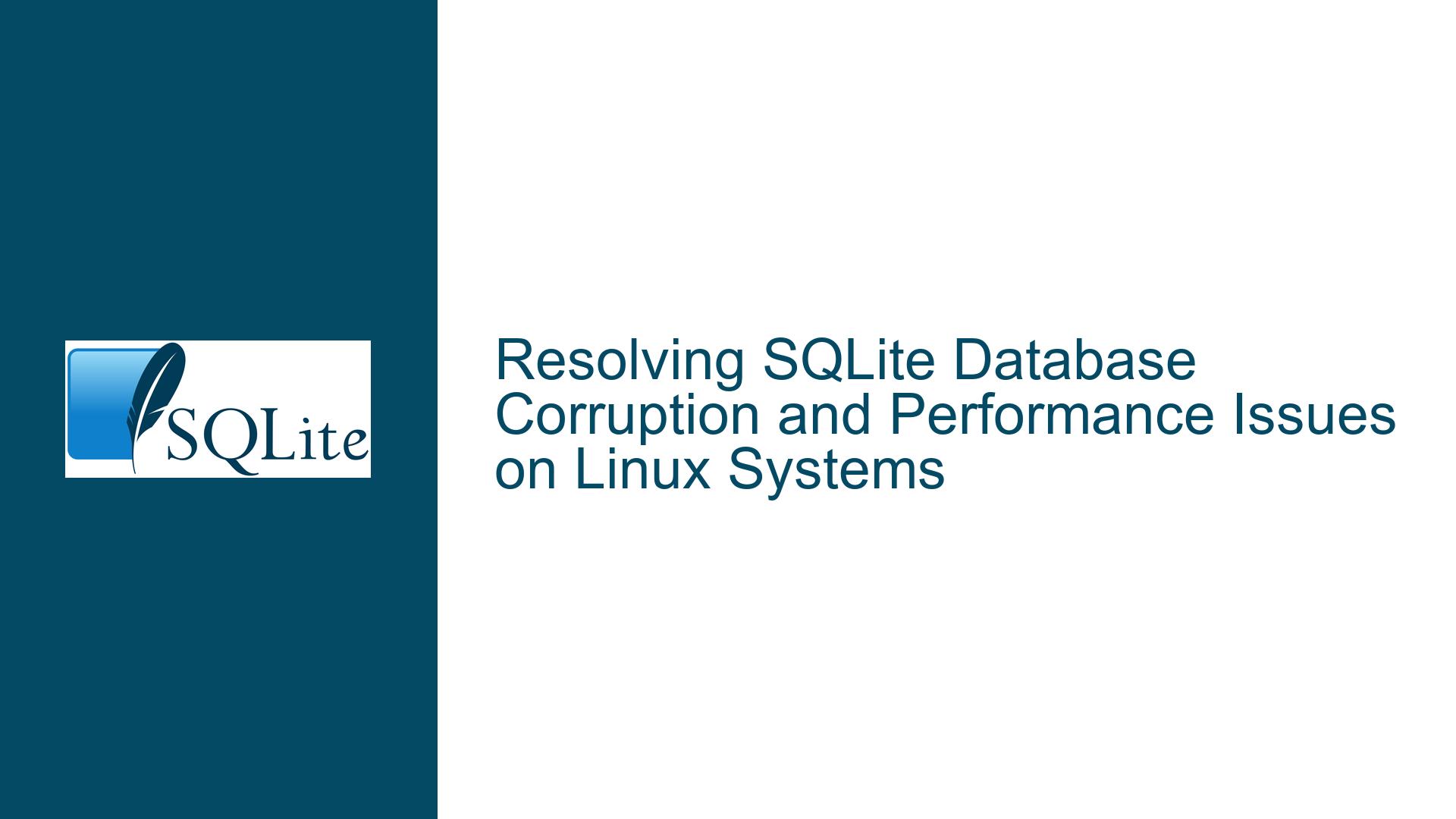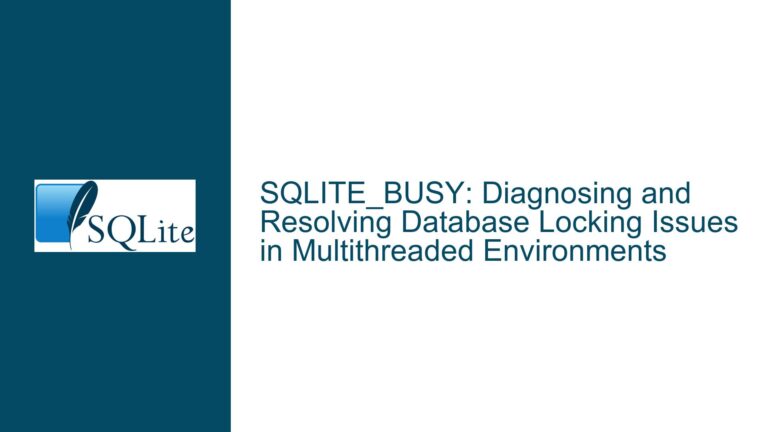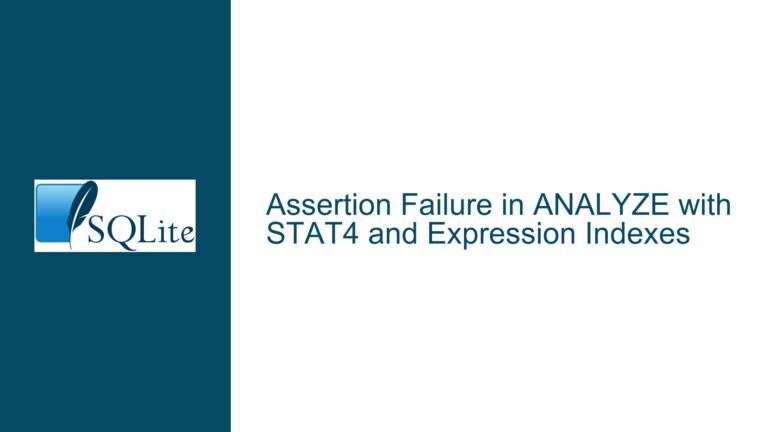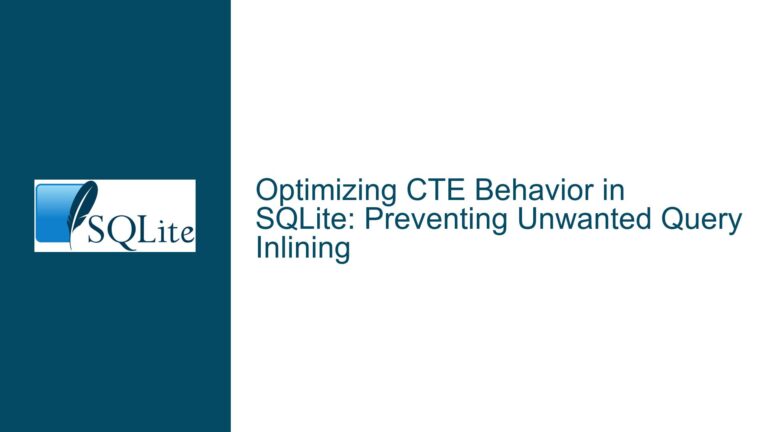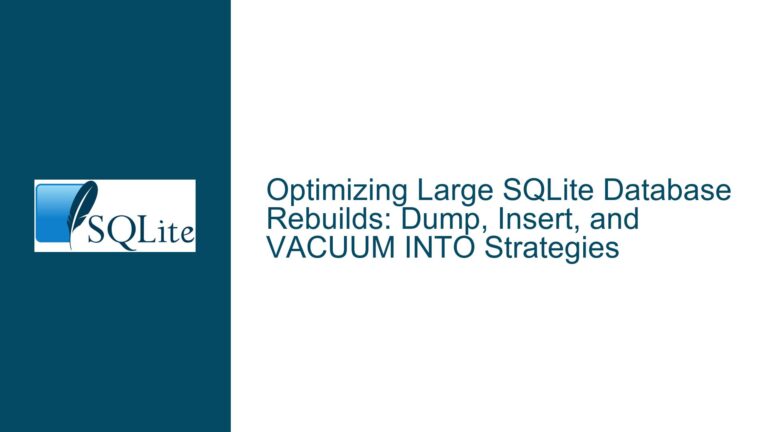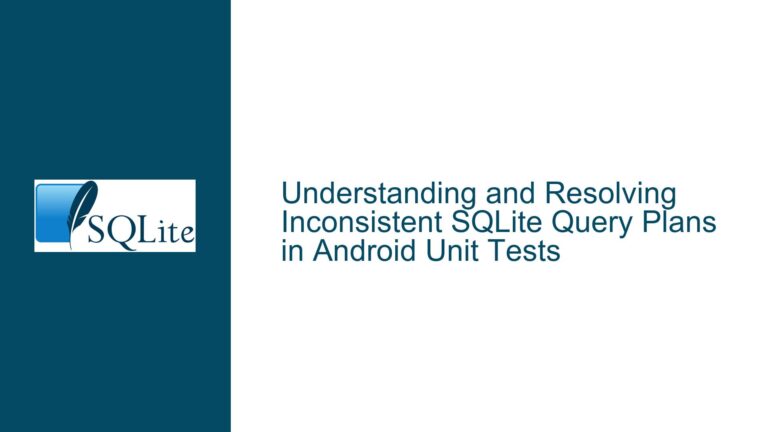Resolving SQLite Database Corruption and Performance Issues on Linux Systems
Understanding SQLite Performance Inconsistencies, File Access Errors, and Corruption Patterns
The core issues described involve three distinct but potentially interrelated SQLite database problems occurring specifically on Linux environments:
- Query Performance Variability Across Devices: Identical databases exhibit significantly different query execution speeds on different Linux systems, resolved temporarily by periodic
PRAGMA optimizeandPRAGMA analysis_limitusage. - Intermittent "Unable to Open Database File" Errors: Occurs during
SELECToperations or index creation, mitigated byPRAGMA temp_store = MEMORY, but persists when PRAGMAs are removed. - Frequent Database Corruption or Data Loss: Observed on Ubuntu Linux 5.4.0-62-generic kernels, accompanied by application crashes and corrupted log files, absent on Windows/Android.
These issues are tightly coupled with Linux-specific filesystem behaviors, SQLite configuration pragmas, and application error-handling practices. The corruption incidents strongly suggest environmental violations of SQLite’s transactional guarantees (e.g., improper filesystem synchronization, file descriptor misuse). Performance discrepancies point to missing or outdated query planner statistics, while "unable to open" errors implicate temporary file handling deficiencies.
Root Causes: Filesystem Interactions, Configuration Missteps, and Error Handling Failures
1. Query Planner Misoptimization Due to Stale Statistics
SQLite’s query planner relies on up-to-date statistics stored in the sqlite_stat1 table to choose optimal indexes. When these statistics are missing or outdated—common when tables are modified extensively without ANALYZE—the planner may select suboptimal indexes. The PRAGMA optimize command (introduced in SQLite 3.32.0, 2020) automatically re-runs ANALYZE for tables requiring updates, while analysis_limit controls how many rows are sampled. Performance discrepancies arise when:
- Databases are copied between systems without preserving statistics.
- Automatic statistics regeneration (e.g.,
auto_vacuum) is disabled. - Query patterns differ across devices, causing planner heuristics to diverge.
2. Temporary File Handling Failures on Debian-Based Systems
The temp_store = MEMORY pragma forces SQLite to use RAM for temporary files instead of disk. Its effectiveness in resolving "unable to open database file" errors indicates problems with the default temporary file directory (/tmp):
- Insufficient Permissions: The SQLite process lacks write/execute access to
/tmpor the directory specified bySQLITE_TMPDIR. - Filesystem Mount Options:
noexec,nodev, ornosuidflags on/tmpprevent SQLite from creating temporary files. - Space Exhaustion:
/tmpresides on a small partition, orinotifylimits are reached. - Filesystem Non-Compliance: Certain Linux filesystems (e.g., network mounts, FUSE) do not fully implement POSIX file locking, causing SQLite’s file-based locks to fail.
3. Database Corruption via Filesystem or Application Layer Defects
The corruption incidents align with scenarios where SQLite’s ACID guarantees are circumvented:
- Journal File Mishandling: If the application or OS interrupts SQLite while journal files (e.g.,
-wal,-journal) exist, incomplete transactions may corrupt the database. - File Descriptor Reuse: The application opens the same database file multiple times, closes a file descriptor prematurely, or shares descriptors across processes.
- Synchronous Setting Overrides: Using
PRAGMA synchronous = OFForNORMALon unreliable storage (e.g., consumer-grade SSDs with volatile cache) risks losing writes during crashes. - Threading Mode Mismatches: Compiling SQLite with
SQLITE_THREADSAFE=0(single-threaded mode) while the application uses concurrent threads violates thread-safety assumptions. - Filesystem Lies: The OS falsely reports that data is flushed to disk (
fsync()failure), a known issue on older Linux kernels and certain storage controllers.
Comprehensive Remediation: Configuration, Monitoring, and Code Audits
1. Stabilizing Query Performance Across Environments
Step 1: Standardize Statistics Collection
- Enable Automatic Statistics Maintenance: Configure
PRAGMA auto_vacuum = INCREMENTAL;and schedule dailyPRAGMA optimize;executions. Avoid relying on manualANALYZEcalls. - Set analysis_limit Appropriately: Use
PRAGMA analysis_limit = 1000;(or higher) to ensure sufficient row sampling for large tables. Combine withPRAGMA optimize(0x01)to limit analysis to tables with stale stats. - Prevent Statistics Loss During Deployment: When deploying databases to multiple devices, include the
sqlite_stat1table. Usesqlite3_analyzerto precompute statistics during build processes.
Step 2: Validate Index Utilization
- Use
EXPLAIN QUERY PLAN: Log query plans across devices to identify index selection discrepancies. Example:EXPLAIN QUERY PLAN SELECT * FROM RegPacks WHERE ADevGUID = ? AND SyncCode = ?; - Force Index Usage (Temporarily): If the planner consistently ignores an index, force its use with
INDEXED BY:CREATE INDEX RegPacks_ADevGUID_SyncCode_idx ON RegPacks(ADevGUID, SyncCode); SELECT * FROM RegPacks INDEXED BY RegPacks_ADevGUID_SyncCode_idx WHERE ...;Revert to automatic selection after updating statistics.
2. Resolving "Unable to Open Database File" Errors
Step 1: Diagnose Temporary File Configuration
- Check
SQLITE_TMPDIR: Ensure the environment variable points to a writable directory. Override in code:sqlite3_open_v2("file:main.db?temp_store=memory", &db, SQLITE_OPEN_READWRITE | SQLITE_OPEN_URI, NULL); - Verify
/tmpPermissions:ls -ld /tmp # Ensure permissions are drwxrwxrwt (1777 sticky bit) df /tmp --output=size,used,avail,pcent # Check space availability mount | grep /tmp # Confirm no restrictive flags (noexec, etc.) - Test Alternative Temporary Stores:
PRAGMA temp_store = FILE; -- Default PRAGMA temp_store_directory = '/custom/tmp'; -- Deprecated but informativeIf
MEMORYresolves issues, allocate sufficient memory viaPRAGMA mmap_size = 268435456;(256MB).
Step 2: Address Filesystem-Specific Bugs
- Use
psowURI Parameter: On systems with faultyfsync(), enable "Power Safe Overwrite":sqlite3_open_v2("file:main.db?psow=1", &db, SQLITE_OPEN_READWRITE | SQLITE_OPEN_URI, NULL); - Avoid Network Filesystems: Store databases on local disks. If unavoidable, use
PRAGMA locking_mode = EXCLUSIVE;and disable WAL:PRAGMA journal_mode = DELETE; -- Default rollback journal
3. Eliminating Database Corruption on Ubuntu Linux
Step 1: Enforce Strict Synchronization and Journaling
- Use WAL Mode Judiciously: While Write-Ahead Logging (WAL) improves concurrency, it complicates recovery on unreliable filesystems. Test with:
PRAGMA journal_mode = WAL; -- Requires shared memory (shm) and wal files PRAGMA synchronous = NORMAL; -- Balance speed and safetyIf corruption occurs, switch to
journal_mode = TRUNCATEorDELETE. - Enable Full Synchronization:
PRAGMA synchronous = FULL; -- Ensure OS buffers are flushedCombine with
PRAGMA journal_size_limit = 1048576;(1MB) to limit WAL growth.
Step 2: Audit Application Error Handling
- Check All SQLite API Return Codes: Ensure every
sqlite3_step(),sqlite3_exec(), orsqlite3_prepare_v2()call is followed by error checking. Example in C:rc = sqlite3_exec(db, "INSERT INTO ...", NULL, NULL, &errmsg); if (rc != SQLITE_OK) { fprintf(stderr, "Fatal error: %s\n", errmsg); sqlite3_free(errmsg); exit(1); // Do NOT continue execution } - Avoid Continuing After Errors: SQLite enters "abort" state after errors, making subsequent operations unsafe. Always reset the database handle after errors:
sqlite3_reset(stmt); // For prepared statements sqlite3_close_v2(db); // Reopen if necessary
Step 3: Diagnose Filesystem and Kernel Defects
- Test with
sqlite3_test_control(): Use SQLite’s internal testing APIs to simulate crash scenarios. Example:sqlite3_test_control(SQLITE_TESTCTRL_FAULT_INSTALL, db, "diskfull"); // Execute operations to trigger disk full errors - Monitor
fsync()Reliability: Usestraceto verifyfsync()calls:strace -e trace=fsync,write -p $(pidof your_app)Ensure all writes to the database and journal files are followed by
fsync().
Step 4: Implement Corruption Detection and Recovery
- Enable Preupdate Hooks: Use
sqlite3_preupdate_hook()to log changes before they’re applied, aiding forensic analysis. - Deploy Checksumming: Add application-layer checksums to critical tables:
ALTER TABLE RegPacks ADD COLUMN data_checksum BLOB; -- Compute CRC32 or SHA1 on data before insertion - Automate Integrity Checks: Schedule periodic
PRAGMA integrity_check;andPRAGMA quick_check;executions. On failure, restore from backup.
Final Configuration Recommendations
For Linux deployments, use these PRAGMA settings as a baseline:
PRAGMA journal_mode = WAL; -- If filesystem supports it
PRAGMA synchronous = NORMAL;
PRAGMA temp_store = MEMORY;
PRAGMA busy_timeout = 5000; -- Retry locked files for 5 seconds
PRAGMA foreign_keys = ON; -- Prevent integrity errors
PRAGMA automatic_index = ON; -- Aid query planner
PRAGMA optimize; -- Run at startup
Adjust based on filesystem testing and workload requirements. Always prefer URI connections with parameters for explicit control:
sqlite3_open_v2("file:main.db?mode=rwc&psow=1&nolock=0", &db, SQLITE_OPEN_URI, NULL);
By methodically addressing filesystem quirks, enforcing rigorous error handling, and tailoring SQLite’s configuration to the deployment environment, developers can eliminate the described corruption and performance issues while maintaining cross-platform consistency.
